Read. Imagine. Travel.
Namaste! With tourism gradually opening up in most parts of the world, we are also seeing an uptick in the overseas travellers wishing to visit Indian subcontinent. In the past few days we have already welcomed few overseas travellers in India including a small group as well as FIT’s. We hope the worst is behind us and we all can move forward from here.
Recognized with the “Safe Travel Stamp”, from WTTC (World Travel and Tourism Council), we are aligned with the ‘Safe Travel protocols’, adhering to our responsibilities as a responsible tour operator and have adopted all health and hygiene global standardized protocols.
Meanwhile, we hope that our virtual travel treats are keeping you inspired and exhilarated. India is a land of many communities living in harmony from time immemorial. In today’s edition, we would like to introduce you to the “Jewish Heritage of India”. The Jews had entered India centuries ago and settled here, making it their new home.
While there are many stories about when and how Jews arrived in India, the recorded history says that they were the first foreign community to settle in India. Many other communities also followed their footsteps later, but Jews were the most peacefully settled group, who blended with the local communities while retaining their original cultural identity. This is evident from the fact that many Jews settled in different parts of India speak the local language, wear local attire, adopted many Indian rituals during their marriage ceremonies like use of turmeric and Heena, a bride wearing Mangalsutra (an auspicious thread worn as a necklace), and many more influenced by the Indian culture.
Once there were around 20,000 Jews in India, but many returned to Israel as soon as it won independence in 1948, which resulted in a decline in the Jewish population in India. Presently, there are around 6000 Jews living with pride in the country and managing approx. thirty-five synagogues, some schools, and cemeteries. They settled here and contributed to the country's progress and development through entrepreneurial, social, defence, art, literature, theatre, bollywood, and many other fields. Watch a video on Story of the Jew community in Kerala
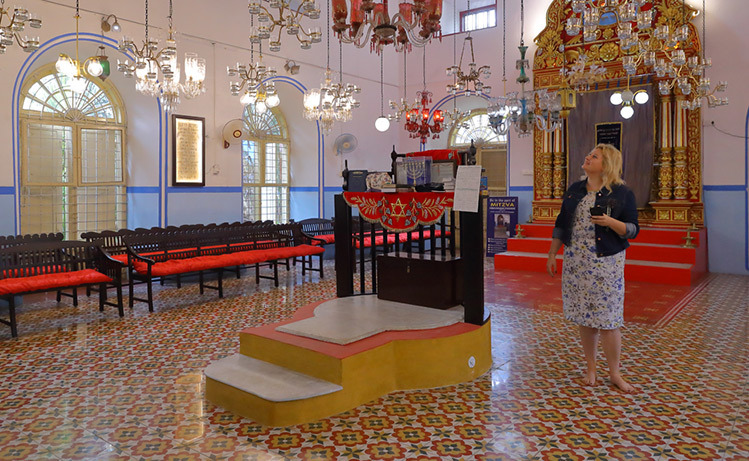
Interesting Fact: The most highlighted example of Jews in India is ‘JFR Jacob’, who was honored with a commendation of merit for his contribution to India's victory in the Indo-Pak war of 1971. He also fought during World War II and in the India-Pakistan war in 1965. After his retirement, he held the position of Governor in the states of Goa and Punjab.
While some believe Jews arrived in India during Judah's Kingdom, the others believe their ancestors to be among Israel's ten lost tribes out of twelve (Judah and Benjamin were the surviving). Without getting into the conflict of the story behind their arrival, we would broadly discuss the three main groups of the Jewish community in this edition: Malabar Jews, Bene Israeli, and Baghdadi Jews.
MALABAR JEWS: These form the oldest settled group of Jews in India and lived during king Solomon's period. They arrived around 50CE along the Malabar Coast in Kerala and were well received by the Chera rulers, who patronized them and helped them build their new lives in his kingdom. During the 12th and 13th centuries, they built many synagogues. By the 16th century, Sephardi Jews from Portugal and Spain also arrived in Cochin. They are known as Paradesi Jews (Foreign Jews). With the decline in the Jewish population post 1948, most of the synagogues could not survive the vagaries of the time.
Some of the historical icons associated with them are:
Paradesi Synagogue: Built-in 1568, it is the only functioning synagogue amongst the seven synagogues of Cochin.

Adorning the Jew town in Fort Kochi, it is a place of worship, and is a treat to the eyes. In this synagogue one can admire the large hall decorated with antiques, large windows, chandeliers imported from Belgium, and even the ceramic tiles used on floors were imported from China.
There are many more interesting treasures in this synagogue, which make it a must visit site during the visit of Cochin.
|
Chendamangalam Synagogue: One of the oldest synagogue’s of Kerala, it was built around 1420 and has a lot of resemblance to Jerusalem Temple. The synagogue was reconstructed in 1614 after it was destroyed by fire. With the migration of Jews to Israel, this synagogue stopped functioning.
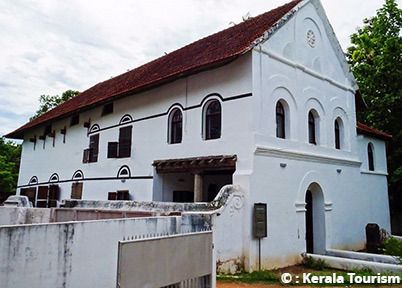 This structure, which was renovated several times, was finally taken over by the Kerala government, restoring to its old charm and converted into Kerala Jews Lifestyle Museum, which exhibits the lifestyle of Jews, their customs, songs, and role of women in their community.
This structure, which was renovated several times, was finally taken over by the Kerala government, restoring to its old charm and converted into Kerala Jews Lifestyle Museum, which exhibits the lifestyle of Jews, their customs, songs, and role of women in their community.
Paravur (Parur): Another synagogue built by Jews, it is one of the largest and blends the fusion of Jewish and Kerala architecture. The religious functioning of this beautiful synagogue also stopped with the migration of Jews to Israel. A few years ago, it was also taken over by the Kerala government, which renovated and converted it into Kerala Jews History Museum. While the structure has many notable architectural features, one among many interesting features is the dedicated space for women to assemble for prayers.
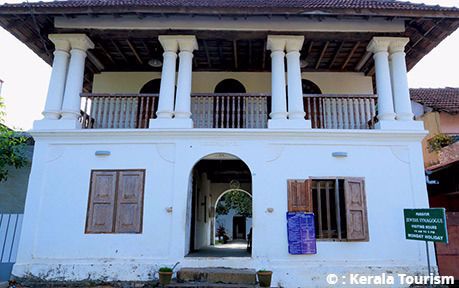 A visit to this synagogue gives one a complete introduction on how Jews arrived in India, lived, socialized, and mixed with other cultures. It also tells about the people who migrated and how they are living presently.
A visit to this synagogue gives one a complete introduction on how Jews arrived in India, lived, socialized, and mixed with other cultures. It also tells about the people who migrated and how they are living presently.
THE BENE ISRAELI JEWS: They arrived in India much later than Malabar Jews but formed the largest Jewish group. According to a legend, a ship was wrecked near the coastline of Mumbai, and only 14 people on board survived, who later settled down in Konkan region of India.
 Another legend also links them to one of the ten lost tribes of Israel. During the colonial rule in India, they took various positions in the British Government, and post-independence, they actively took onscreen and off-screen roles in Bollywood.
Another legend also links them to one of the ten lost tribes of Israel. During the colonial rule in India, they took various positions in the British Government, and post-independence, they actively took onscreen and off-screen roles in Bollywood.
Interesting Fact: As Bene Israeli Jews had arrived in India as merchants, they took up different trades, and the most common was Oil pressers (meaning ‘Teli’ in Hindi). They had reserved, Saturday (Shanivaar) for Sabbath (to perform their prayers). They did not perform any official work on this day and for that reason, they were also called Shanivaar Telis.
Some of the historical icons associated with them are:
Beth Ha- Elohim Synagogue, Pen (Maharashtra):
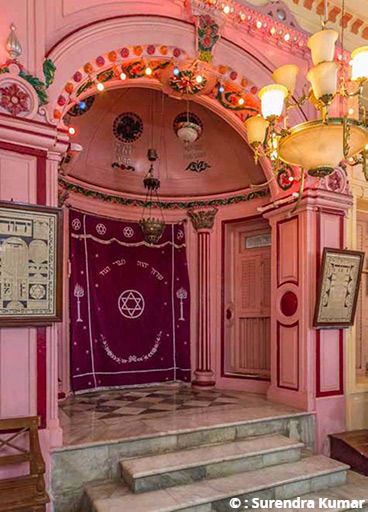
Pen had been a center of trade, education, and culture due to its location along a trade route. Many Bene Jews settled here and lived in harmony along with other communities and built their religious worship places as well. Beth Ha Elohim, which means in Hebrew God's house, was built in two phases by Bene Israeli Jews. The first synagogue was built with the contribution of affluent Jewish members around 1863, and the second one to accommodate larger gatherings was constructed in 1893.
What is seen today is the second one which withstood the test of time.
The gate of mercy Synagogue Mumbai: Even though the synagogue is built in Mumbai, it has a Mysore connection to its origin. Samaji Hasaji Divekar, who built this synagogue, was a part of the British army and settled in Mumbai. During the conflict with Tipu Sultan's army, he was captured and taken to Mysore, but Tipu Sultan's mother intervened, realizing his Jewish roots. She saved his life and further made him to be included in Tipu Sultan's army. So, after accumulating wealth from his service, he returned to Mumbai and built the first synagogue of Mumbai. As the wealth was earned from his services in Mysore, the synagogue received its Mysore connection.
Bene Israel cemetery Mumbai:
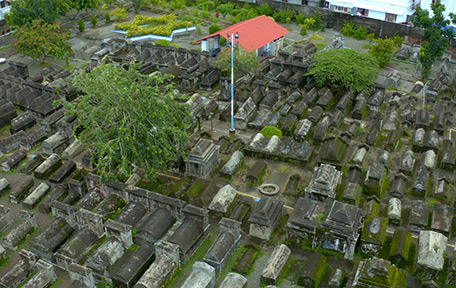
Spread in around two acres of land, this Jewish cemetery holds three Victorian-styled mausoleums built for Sassoon family members, whose architecture attracts attention. It also showcases the atrocities faced by Jews at the hands of Nazis.
The cemetery has around 1000 graves within the complex.
Magen Abraham Synagogue, Ahmedabad: The art-deco styled synagogue is the only synagogue in Gujarat. The synagogue has many religious artefacts, like stained glass windows, chandeliers, grills etc. But the most amazing among them all is the women's balcony, which has no support of pillars and is unique to this synagogue.
BAGHDADI JEWS: Originally from Iraq, Baghdadi Jews were feeling suppression under the Muslim rulers of Baghdad. During the 18th & 19th centuries, trade and commerce flourished in British India and they chose to migrate here as traders and settled in Mumbai and Kolkata regions.
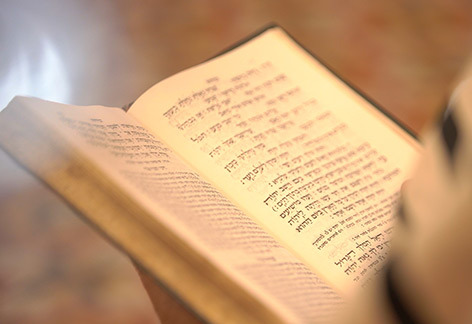
They indulged in different trades like opium, cotton, jute, and many other businesses. Their business flourished, and by the 19th century, they became the richest of all other Jews residing in India. They also contributed to society, religion, and their community.
The most affluent among them were the Sassoon family, and for that reason, they were also called ‘Rothschilds of East’.
Insider Tip: When in Kolkata, do not miss to taste the delicacies in the iconic Jewish bakery Nahoum & Sons, which still retains its old-world charm and taste. The delicacies it served, especially the fruit cake, made it popular right from its inception among the British and local Bengali population.
Some of the historical icons associated with them are:
Magen David Synagogue in Byculla (Mumbai): The most beautiful synagogue in the country, it is considered one of the largest in Asia (outside Israel).

The bright blue Victorian-styled Synagogue was built in 1864 and was expanded in 1910 considering the increasing population of Baghdadi Jews. Within the complex, there are two schools as well, which are run by the Sassoon trust.
The stunning building is admired for its stained glass, blue façade, and columns. There is also a clock tower that adds to its beauty.
David Sassoon Library, Mumbai:

One of the prominent heritage structures in Mumbai, this Library, was built by David Sassoon in collaboration with the British Government. Be it the Venetian Gothic-styled structure or its antique furniture; every corner of the place reflects history.
Sassoon Docks: It is the oldest dock and the first wet dock in Mumbai. Amongst the few docks opened for the public in India, Sassoon Docks is also known for its fish market, where around 20 tonnes of fish are brought every morning. During an early morning visit to this dock one can see the fresh fish arriving and being auctioned.
Knesset Eliyahoo synagogue in Colaba:
This beautiful building is an architectural marvel that is a blend of Indian, Jewish, and English traditions. The structure with turquoise façade has a basement made up of stone masonry and the superstructure of brick masonry. It is also known as the Blue Synagogue of Mumbai.
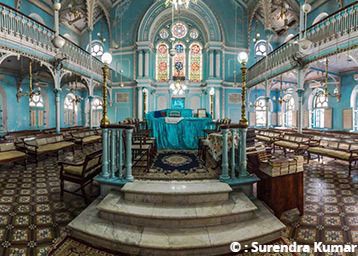
India is dotted with numerous architectural gems created by the Jews. The list is long and diverse and it is no justice to sum it up in few words. Come and discover the amazing culture of jews residing in India with us! At Indo Asia Tours, the itinerary is not just a travel route or a trip. We design, conceptualise and handcraft every journey. Our special customised itineraries and curated experiences in different destinations are what make for those memorable travel moments.
|
Virtual Destination Training Program
|
 We can conduct a virtual destination awareness training program for your team or yourself or a virtual tour for your clients. Let us know the destination of your interest along with your convenient date / time and we will be happy to set up a program for you.
We can conduct a virtual destination awareness training program for your team or yourself or a virtual tour for your clients. Let us know the destination of your interest along with your convenient date / time and we will be happy to set up a program for you.
Send Request
|
Please feel free to write back to us at marketing@indoasiatours.com to share our thoughts on customized journeys covering the Indian subcontinent or take time to visit our website https://www.indoasia-tours.com. Be sure we will prepare the best program to make a memorable trip for your esteemed clients!
|
|


 Adorning the Jew town in Fort Kochi, it is a place of worship, and is a treat to the eyes. In this synagogue one can admire the large hall decorated with antiques, large windows, chandeliers imported from Belgium, and even the ceramic tiles used on floors were imported from China.
Adorning the Jew town in Fort Kochi, it is a place of worship, and is a treat to the eyes. In this synagogue one can admire the large hall decorated with antiques, large windows, chandeliers imported from Belgium, and even the ceramic tiles used on floors were imported from China.
 This structure, which was renovated several times, was finally taken over by the Kerala government, restoring to its old charm and converted into Kerala Jews Lifestyle Museum, which exhibits the lifestyle of Jews, their customs, songs, and role of women in their community.
This structure, which was renovated several times, was finally taken over by the Kerala government, restoring to its old charm and converted into Kerala Jews Lifestyle Museum, which exhibits the lifestyle of Jews, their customs, songs, and role of women in their community.
 A visit to this synagogue gives one a complete introduction on how Jews arrived in India, lived, socialized, and mixed with other cultures. It also tells about the people who migrated and how they are living presently.
A visit to this synagogue gives one a complete introduction on how Jews arrived in India, lived, socialized, and mixed with other cultures. It also tells about the people who migrated and how they are living presently.
 Another legend also links them to one of the ten lost tribes of Israel. During the colonial rule in India, they took various positions in the British Government, and post-independence, they actively took onscreen and off-screen roles in Bollywood.
Another legend also links them to one of the ten lost tribes of Israel. During the colonial rule in India, they took various positions in the British Government, and post-independence, they actively took onscreen and off-screen roles in Bollywood.
 Pen had been a center of trade, education, and culture due to its location along a trade route. Many Bene Jews settled here and lived in harmony along with other communities and built their religious worship places as well. Beth Ha Elohim, which means in Hebrew God's house, was built in two phases by Bene Israeli Jews. The first synagogue was built with the contribution of affluent Jewish members around 1863, and the second one to accommodate larger gatherings was constructed in 1893.
Pen had been a center of trade, education, and culture due to its location along a trade route. Many Bene Jews settled here and lived in harmony along with other communities and built their religious worship places as well. Beth Ha Elohim, which means in Hebrew God's house, was built in two phases by Bene Israeli Jews. The first synagogue was built with the contribution of affluent Jewish members around 1863, and the second one to accommodate larger gatherings was constructed in 1893.
 Spread in around two acres of land, this Jewish cemetery holds three Victorian-styled mausoleums built for Sassoon family members, whose architecture attracts attention. It also showcases the atrocities faced by Jews at the hands of Nazis.
Spread in around two acres of land, this Jewish cemetery holds three Victorian-styled mausoleums built for Sassoon family members, whose architecture attracts attention. It also showcases the atrocities faced by Jews at the hands of Nazis.
 They indulged in different trades like opium, cotton, jute, and many other businesses. Their business flourished, and by the 19th century, they became the richest of all other Jews residing in India. They also contributed to society, religion, and their community.
They indulged in different trades like opium, cotton, jute, and many other businesses. Their business flourished, and by the 19th century, they became the richest of all other Jews residing in India. They also contributed to society, religion, and their community.
 The bright blue Victorian-styled Synagogue was built in 1864 and was expanded in 1910 considering the increasing population of Baghdadi Jews. Within the complex, there are two schools as well, which are run by the Sassoon trust.
The bright blue Victorian-styled Synagogue was built in 1864 and was expanded in 1910 considering the increasing population of Baghdadi Jews. Within the complex, there are two schools as well, which are run by the Sassoon trust.
 One of the prominent heritage structures in Mumbai, this Library, was built by David Sassoon in collaboration with the British Government. Be it the Venetian Gothic-styled structure or its antique furniture; every corner of the place reflects history.
One of the prominent heritage structures in Mumbai, this Library, was built by David Sassoon in collaboration with the British Government. Be it the Venetian Gothic-styled structure or its antique furniture; every corner of the place reflects history.
 India is dotted with numerous architectural gems created by the Jews. The list is long and diverse and it is no justice to sum it up in few words. Come and discover the amazing culture of jews residing in India with us! At Indo Asia Tours, the itinerary is not just a travel route or a trip. We design, conceptualise and handcraft every journey. Our special customised itineraries and curated experiences in different destinations are what make for those memorable travel moments.
India is dotted with numerous architectural gems created by the Jews. The list is long and diverse and it is no justice to sum it up in few words. Come and discover the amazing culture of jews residing in India with us! At Indo Asia Tours, the itinerary is not just a travel route or a trip. We design, conceptualise and handcraft every journey. Our special customised itineraries and curated experiences in different destinations are what make for those memorable travel moments.
 We can conduct a virtual destination awareness training program for your team or yourself or a virtual tour for your clients. Let us know the destination of your interest along with your convenient date / time and we will be happy to set up a program for you.
We can conduct a virtual destination awareness training program for your team or yourself or a virtual tour for your clients. Let us know the destination of your interest along with your convenient date / time and we will be happy to set up a program for you.

